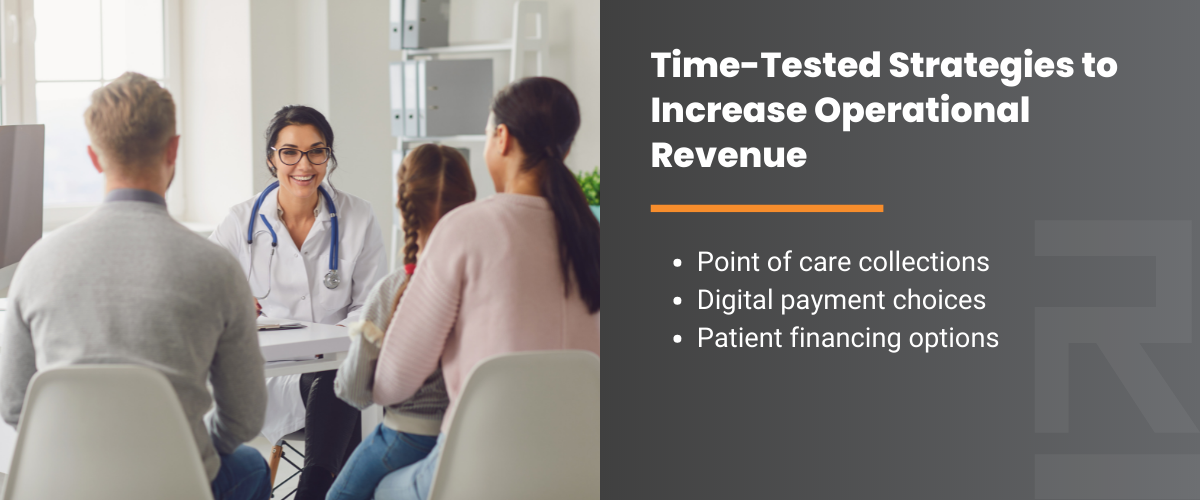As a healthcare leader, optimizing operational revenue is top priority for your organization. You’ve likely updated your billing systems and processes to maximize insurance revenues. But have you invested similar time and effort into streamlining the patient side of your revenue cycle?
Patient payments represent a significant and growing share of operational revenue. In 2021, patient payments totaled nearly $500 billion, with a predicted annual growth rate of 10% through 2026, according to a Kalorama Information study.
The driving force behind this trend is increasing deductibles, copayments, and coinsurance. The Kaiser Family Foundation found that the average single health insurance deductible was $1,669 in 2021, up from $991 in 2011. And more U.S. workers have a deductible with their plan — 85% in 2021 vs. 74% a decade ago.
Despite the importance of patient payments, healthcare organizations struggle to collect them. According to a 2021 Commonwealth Fund survey, one-third of insured adults experienced problems with medical bill debt over the past year.
No doubt, collecting payments from patients can be as complex as providing healthcare itself. But there are several time-tested strategies that can increase operational revenue and decrease bad debt. These include:
- Point of care collections
- Digital payment choices
- Patient financing options
By combining these strategies with digital solutions, you can take the mystery out of patient collections and see your cash flow rise.

Capturing Payment Information Before the Visit to Enhance Point of Care Collections
The old model of medical payment relied on an informal agreement between the patient and provider. Payment was not expected until months after the visit and involved mailed statements and paper checks. The inefficiencies and inconveniences of this system waste the time of patients and staff and delay accounts receivable.
Most healthcare organizations have realized that these outdated manual processes are no way to run a business. Many attempt to collect copays up front, but most have not achieved the retail-like experience patients expect these days. A survey by CWH Advisors found that nearly two-thirds of respondents would like more digital options for paying their healthcare bills.
One way to do this is to collect credit card information as part of an online registration process. Having a card stored securely on file helps capture payment and facilitates point of care collection without adding another layer to checkout. Card-on-file technology also supports online payment options and patient financing flexibility.
Providing Digital Payment Options for Patient Balances
Patient preferences for making healthcare payments are shifting toward contactless, mobile options. By 2023, JP Morgan projects the vast majority of e-commerce sales will be dominated by credit card (58%) and digital wallet (27%) transactions. About half of these transactions occur on a mobile device.
Smartphone-based payment methods eliminate points of resistance in the payment process. They leverage the power of text communications that patients prefer over phone calls and voicemails.
With text-to-pay technology, you can send patients billing statements with a link to pay directly from their phone. And with the tap of a screen, patients can quickly and easily settle their bill or communicate with the office. The results are accelerated collections and improved patient satisfaction.
Offering Patient Financing Alternatives to Make Balances More Manageable
Healthcare costs can be a barrier to care. More than 70% of people report that the cost of care affects their decision to see their doctor, according to the CWH Advisors survey. Avoiding visits due to high out-of-pocket costs not only threatens people’s health, it also decreases patient volume.
A patient financing option linked to a credit or debit card on file offers a consumer-friendly opportunity to get care now and pay later. It allows patients to afford care and providers to receive regular payments. Nearly two-thirds of respondents to a PYMNTS survey expressed significant interest in patient financing to avoid accruing bad debt.
Patient financing technology also helps you avoid costs associated with a third-party billing or collection company.
Steady payments and reduced billing costs mean your bottom line shifts from underperforming to prospering.
Rectangle Health’s Solutions for Maximizing Operational Revenue
Rectangle Health offers digital patient payment solutions for healthcare organizations of all sizes. Our core product, Practice Management Bridge®, consolidates patient payment processes and interfaces seamlessly and securely with your existing practice management system. By reducing friction along the revenue cycle continuum, our platform improves:
- Cash flow
- Office efficiency
- Patient experience
At Rectangle Health, we understand the significance of offering automated options for contactless payments. That’s why we offer features such as Text-to-Pay, mobile payments, online payments, Card on File, point-of-care payments, and patient financing. Practice Management Bridge also supports digital registration forms and custom text messages to help you communicate efficiently with your patients at precisely the right time.
To learn more, schedule a demo today.
References
- Kalorama Information. (2021, July 29). U.S. out-of-pocket healthcare spending swells to $491 billion, up 10%. Retrieved online April 11, 2022, from https://kaloramainformation.com/blog/press/u-s-out-of-pocket-healthcare-spending-swells-to-491-billion-up-10/.
- Kaiser Family Foundation. (2021, November 10). Average Family Premiums Rose 4% This Year to Top $22,000; Employers Boost Mental Health and Telemedicine amid COVID-19 Pandemic, Benchmark KFF Survey Finds. Retrieved April 11, 2022, from https://www.kff.org/health-costs/press-release/average-family-premiums-rose-4-this-year-to-top-22000/.
- The Commonwealth Fund. (2021, July 16). As the pandemic eases, what is the state of health care coverage and affordability in the U.S.? The Commonwealth Fund. Retrieved February 4, 2022, from https://www.commonwealthfund.org/publications/issue-briefs/2021/jul/as-pandemic-eases-what-is-state-coverage-affordability-survey.
- P. Morgan. (2020). 2020 E-commerce Payments Trends Report: US. Retrieved April 11, 2022, from https://www.jpmorgan.com/insights/payments/acquiring-and-e-commerce/key-trends-to-drive-your-payments-strategy.
- PYMNTS, Rectangle Health. (2021, January). The Healthcare Payment Experience Report. PYMNTS, Rectangle Health. Retrieved April 11, 2022, from https://www.pymnts.com/wp-content/uploads/2021/01/PYMNTS-The-Healthcare-Payment-Experience-Report-January-2021.pdf.



